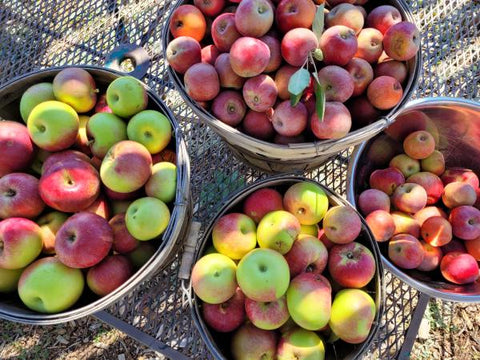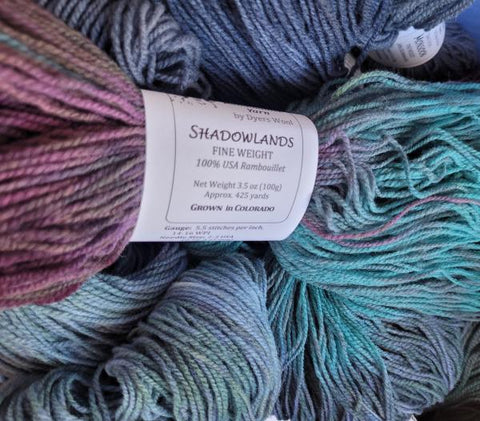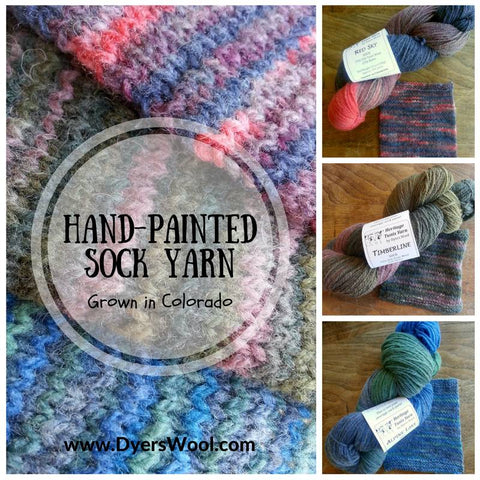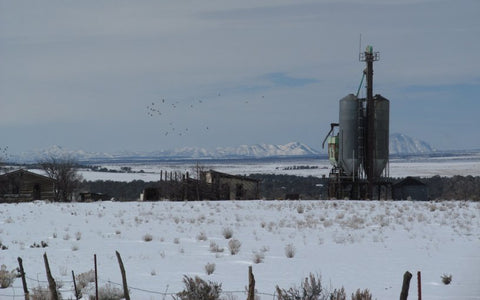What's Happening
For the latest updates, check out our Instagram Feed:
Preparing for the Santa Fe Wool Festival September 28 2023

In one week, I’ll be loading our trailer for the MAVWA Wool Festival in Santa Fe, NM. It’s been a difficult month for us, but we’re still excited to bring all our lovely wool products and more to our customers at the festival. We have lots of new colors, products, and variations of our offerings.
My mom, Pam, is having back problems that will prevent her from attending the festival this year. My kids and husband will be helping me run the booth while my mom and dad stay home. Pam will miss seeing you all, but this was the best decision for her health.
Our garden and orchard produced wonderfully this year, and I've also been busy harvesting and putting up a lot of food this month. On top of that and my mom's back problems, my daughter broke her foot. When it rains it pours, eh?

Look at all those apples!

Pear rings and pear leather in the dehydrator.

Abbey enduring the cast and crutches with fairly good spirits.
I’ve been dyeing up a storm this month. It’s always easiest to do most of the dyeing at once, while I have my tables and equipment set up on our back porch. It is such a lovely location to spend time—I get to overlook my garden and backyard orchard, enjoy the flowers, and listen to the birds. Dyeing is hard work, but a nice setting makes it enjoyable.

We have some new Shetland roving, Rambouillet combed top, and Rambouillet fine-weight yarn colorways. It’s always fulfilling to work with our lovely homegrown Shetland roving, and Rambouillet is such wonderful wool to work with—I’m excited to share the results with you. Don’t forget all our wool is grown in Colorado!


We are offering Navajo Churro this year in our discounted 8 oz roving balls, in addition to the Corriedale and Shetland. I also created multi-colored bundles of odds-and-ends roving that are perfect for any fiber artist looking for color options. These bundles contain a variety of roving thicknesses from all the wool we typically just add to our own personal stash—remnants, the thin roving that first comes off the machine, and others. At a price that can’t be beaten, we think our customers are going to love this new offering.

Don’t forget now is the time to purchase gifts for your friends and family. We will be offering numerous quantity discounts at the festival, so make sure you come by to see us!
- Kelsey

Lots of New Products November 15 2016
If you haven't been following us on social media, you've been missing out on our new products! There's just not enough hours in the day (less now that it's fall), and I'm only now getting around to this blog post. Sheesh!
This summer, we came up with a new way to dye our Colorado-grown yarns that would allow us to more intricately hand-paint them and still avoid plastic. We avoid using plastic wrap or bags in the heat-setting of our dyes because we don't want our homes or our yarn filled with chemicals that result from heating plastic. Using non-toxic "acid" dyes - meaning they're set with vinegar - we hand-dye all our yarns in our home kitchens and want to keep everything safe for ourselves, our family, and our customers. Anyway, with the new method, we were able to create six new colorways in our sock and bulky yarns. Here's a peak at the three sock colorways:

Some of those colorways were so lovely we decided to dye some of our new Colorado-grown Rambouillet combed top, and are offering the natural as well as the dyed top:

The third new and exciting product is not a new product, per se, but an improvement on an existing one. Our stitch marker necklaces (charm necklaces whose charms are stitch markers) were previously offered in two styles - one with the charms on a chain and one with a large clasp on a cotton cord. Now we have added a sterling silver clasp to the chain version, for much easier use of the stitch markers:

That's it for now. Keep your eyes open for our upcoming promotion for Small Business Saturday (Nov 26)!
Thanks & take care!
Kelsey
What's in a Name? - Red Mesa Heritage Blend Yarn April 18 2015
We've talked about the wool that went into our Red Mesa Heritage Blend Yarn, a 50/50 mix of Colorado-grown Corriedale and Tunis, but we haven't explained why we call it Red Mesa Heritage Blend. Well, there's a story there; it's a story of location and community. Red Mesa is a town just south of the main Dyers Wool farm, but it's also the name for the general area and surrounding community. The town is not what it used to be - it used to be a thriving dryland farming hub, but now it doesn't even have a post office. Yet there's something about the people here that makes it special. It's not the easiest place to live, as it's called the "Dryside" for the lack of abundant water, but somehow I think that makes the people stronger and kinder. They are good people, good neighbors, and good friends.

An old, abandoned beanery north of Red Mesa is a testament to the former thriving agriculture in the area.
We didn't just name the yarn after the area we farm. The name Red Mesa also invokes the flavor of our region. We are lucky to live and farm between the Colorado mountains to the north, and the Southwest desert to the south, and we enjoy visiting both places. In just a few hours drive, we can visit Chaco Culture National Historic Park in New Mexico, Cedar Mesa in Utah, or Monument Valley in Arizona/Utah. The canyons draw us, for both their beauty and the treasures they hold. My husband, Trent, and I are both archaeologists by training, and our love for our region's history takes us, and the family, on wandering adventures in remote canyons.

Chaco Canyon is one of our favorite places to visit in the winter.
The canyons and the desert vistas are so inspirational in their myriad colors. A desert sunset is a vibrant, awesome event, and we're blessed with more such vistas than we stop to appreciate. Desert dawn is one of my favorite times, and a summer monsoon storm drastically changes the desert landscape's colors and scents. Plants in the desert are wise, hardy creatures whose beauty is most visible in their ability to endure, yet when the conditions are right and the rains have come, they'll burst into bloom and amaze us with their vibrancy.

Our rainbow of desert-inspired colors.
There is inspiration also in the knowledge that our feet are not the first to walk these paths, and you can feel the echos of the past when you spot a broken pottery sherd alongside the trail, or your eye catches the faint outline of a pecked symbol in the cliff-face. There is history in this area, and deep mysteries. It is humbling.

Hand prints in Cedar Mesa. Could any of these hands be those of ancient spinners and weavers?
There's another story to our yarn - it was made possible by the support of our community of friends. The heritage Tunis wool is raised by our friend, John, who lives just up the road from the main Dyers Wool farm. Actually, he's more than just a friend - he's my former Wildland Fire Captain, from when I volunteered for the local fire department. This man exemplifies what I was talking about when I said the people in the Red Mesa area are amazing. I developed immense respect for him when serving with him on the fire department, and literally trust him with my life. I know if I ever needed help with ANYTHING at all, he would be there. He also has a great sense of humor.
The Corriedale wool came from our friend and fellow spinning guild member, Pam (there are too many Pams in the area that work with wool!), who lives on the eastern edge of our county. Her sheep enjoy lush pastures and great health at the base of the gorgeous HD Mountains. The fiber she produces is amazing - she is a former operator of a fiber mill, so she KNOWS her fiber!
Then there are a few other members of the local spinning guild who have really contributed to this yarn. Branding this yarn, from blend name to label to colorway names, would not have been possible without the copious advice and feedback from our wonderful French-bulldog-loving friend, Sheila (credit for the "Red Mesa" brand name goes to her husband). Thanks again, Sheila!

There were many renditions of the labels, with EXCELLENT feed back from Sheila, before we settled on these.
Lastly (but not least), are our friends who, when the yarn came back from the mill, we gave a skein of the new yarn to try out and play with. We needed feedback and they jumped into projects with the yarn almost immediately. They gave us great, and honest, responses, which helped us improve packaging and figure out the labeling, description, and advertising of the yarn. Most amazingly to me, two of them knit up their yarn into projects that they then GAVE back to us to be used as display pieces - thank you Susan and Carole!

Susan's gorgeous shawl in our Desert Rose sport weight yarn.

Carole's super fun Dr. Who-themed hat. (The Tardis is easily seen on the side, but there are also Daleks on the top!)
We really are blessed with an amazing community of neighbors, wool-growers, fellow fiber-artists, and friends. That is why the name of our community as the brand name of the yarn was so fitting. We see ourselves as more than just a retail fiber shop - we try to provide unique products with important stories of friendship, community, sustainability, and history, and encourage or support other fiber-producers however we can. I hope the inspiration we find in our community and the desert southwest inspires you in turn.
Thanks for reading and happy spring!
- Kelsey
It's Time to Spin November 04 2014
Fall is definitely here. Frost has put the garden to bed for the year, and there's snow on the mountains. We had a great year for tomatoes and peppers, which we stored for the winter by freezing, canning, and dehydrating.

I find myself gravitating toward my spinning wheel now, despite the fact I should be making inventory for the holiday season, cleaning the always-dirty house, or doing some other tangibly productive activity. Going back to my wheel and spinning is such a soothing activity in light of how busy we have been. I always look forward to winter days when there's a fire in the fireplace, snow flurries outside, and I can sit down and do some spinning. My husband laughingly says Sundays are a good day for me to spin, because football is on TV and I wouldn't have the attention-span to sit and watch it with him if I weren't spinning. The sheep are all nice and snug in their warm fleeces - it is always amazing to see the frost on them early in the morning - and that makes my fingers itch to spin up some warm handspun for winter hats and gloves.

I've enjoyed working with some of our dark brown Corriedale roving, which spins up like a dream, but now I'm clearing off my bobbins for my true passion - our homegrown Shetland wool. I finished plying some of our shaela (charcoal) wool from last year (from Caprica, the dark ewe in the above photo). It is such an easy spin, and one of my favorite colors. This year's crop looks to be as nice as last year's.

I'm very conscious about the quality of our Shetland roving, as I'm constantly evaluating our breeding program and many mills seem to have trouble processing Shetland fiber well. We've had it come back from the mill with noils, which could be on the mill's end from over-carding or -washing, or on our end from wool quality or biological issues (mites etc.). Additionally, our Shetlands do experience a "rise" of their wool, which is a historic trait of the breed that allowed Shetland shepherds to "roo," or pull/comb out, their sheep's wool instead of shearing. If we don't time shearing just right, we can get a natural break in the wool before or after shearing. Then there's always the vegetable matter, or VM, issue in roving as we don't coat our animals. Some fleeces just seem to attract VM, and the silly ram lambs sit in their hay while eating! It's enough to drive a shepherd mad!

With the limited number of Shetland sheep we have, and the small fleece sizes, we use a small mill who is willing to do small batches of each color for us, but small mills just don't have the capabilities of the larger ones. With all these concerns, it's always nice to evaluate the wool through spinning, even though we've gotten very good at judging the wool quality when we open up the shipping boxes fresh back from the mill. Anything that doesn't meet our quality standards is relegated to felting, woven roving pot holders, or pillow stuffing, although we do expect fellow spinners and fiber artists to understand our roving did come from a live farm animal and is not combed top. (On the subject of combed top, we feel that would be a disservice to Shetland fiber, as its beauty is in a woolen spin.)
I was a little leery when I sat down to spin some of our moorit (brown) Shetland roving from our ewes, Bonnie and Claire. I could tell it was nice and soft, and I knew the fiber staple was 4+ inches (I can't spin short fibers well), but there were some visible noils and VM. Not horrible, but when you only have two moorit ewes, it's tough to see your precious brown wool come back anything less than perfect. I started to spin, and a minute into it I was very, very happy; it was a great spin! The VM tended to fall out as I spun, and what didn't was easy to pick out, and the noils were very easy to pick out of the wool or even the yarn. That was a very different experience of noils than I've had in the past, and it hardly slowed me down. It spun as fast as the Corriedale roving, and soon I had a full bobbin.

Next I have my eye on the gorgeous gray roving from Cameron and Chloe. I had written off their fleeces as too coarse, but it came back from the mill as a lusciously soft, luminous gray shot through with darker (albeit, coarser) fibers. There are some noils visible in it, but I'm hoping they'll be as easy to handle as in the moorit roving. I'm watching the weather report, looking for the next nice spinning day - wind, snow, freezing temperatures, and maybe some football. It's time to spin.
Thanks for reading!
- Kelsey
A Great Salida Fiber Festival September 12 2014 1 Comment
Many thanks to all the Salida Fiber Festival volunteers, our customers, and our locker hooking students this past weekend! It was a great festival, with amazing attendance, and even the weather cooperated (it was a bit windy, and some storms threatened but never really rained). Our Colorado-grown roving was a huge hit, and everyone loved accessorizing their woolen items with our handmade shawl pins. Looks like we'll be busy this month restocking our inventory for the Wool Festival at Taos!

We packed as much into our 10 x 10 booth as possible.

See all that gorgeous hand-dyed Corriedale roving? We should have done more; it was almost gone by the end of Saturday!

Vertical displays are the only way to go with all our diverse products.

Pam's class on locker hooking went well. Between the class and her demo on Sunday, we have many more people "hooked" on locker hooking (sorry, I couldn't help myself with that pun).
Thanks again to everyone - especially our helpers, Jim, Trent, and Abby - and to you for reading!
- Kelsey
Coming Soon from Dyers Wool - Mill-spun Colorado-Grown Yarn July 23 2014
I found it pretty exciting to send off over 250 lbs of wool off to the mill to be made into yarn, but maybe that excitement was because we were done skirting, sorting, and packaging 250 lbs of wool! It was a lot of work, but it will be so fun to get the yarn back. The yarn will be a 50/50 Corriedale/Tunis* blend, and will be available in a worsted yarn and a sock yarn with 25% nylon for durability. We will offer the yarn in plain and dyed 4 oz. skeins.
Both the Corriedale and Tunis fleeces were grown by farmer/friends near us in Colorado.

The Corriedale fleeces are so gorgeous!

I forget the exact numbers, but I think it was about 20 fleeces each of Corriedale and Tunis. That's a LOT of skirting!
* The Tunis sheep is one of the oldest indigenous breeds in the U.S., and were preferred by Thomas Jefferson over Merinos. They are a heritage breed listed on the American Livestock Breed Conservancy: http://www.livestockconservancy.org/index.php/heritage/internal/tunis. The wool is soft to medium, semi-lustrous, and resists felting.
Thanks for reading!
- Kelsey
Packing Day March 20 2014
The fleeces are all skirted and sorted, so today we packed them up to be sent off and processed into roving. It's a lot of work, but very exciting to know that this year's crop of fleeces will soon be back and ready!


One of our Navajo Churro ewes, Amber, had the most amazing staple - 14" in length or so. That is why it is so important to send our wool to a mill who won't cut the long-stapled wools.
Happy spring, everyone!
- Kelsey
Shearing Day 2014 March 18 2014
It was a cold and windy day this year for shearing day. We all bundled up as much as possible and had Abby (our toddler) sit in the dog house out of the wind. Our friend, Susan, came and helped us, thankfully! Nick, our shearer, did a great job as usual. I didn't take as many photos as usual, because my fingers didn't want to work in the cold. I felt a little bad taking the sheep's coats off on such a day, but I think they're a lot tougher than I am!


I was excited to see my moorit (brown) Shetland ewe, Claire, hasn't faded. This is her second shearing and her fleece is definitely dual, but soft and wavy.

Caprica, our shaela (steel gray) Shetland cross ewe, had another gorgeous fleece. I thought she would coarsen by her second year, but her fleece is still soft, crimpy, and has great staple length. Hers is a single-coated fleece.

We were please with our Shetland ram's (McIntosh) soft, wavy, pearly fleece. Shearing day is like Christmas!
Take care and stay warm!
- Kelsey
